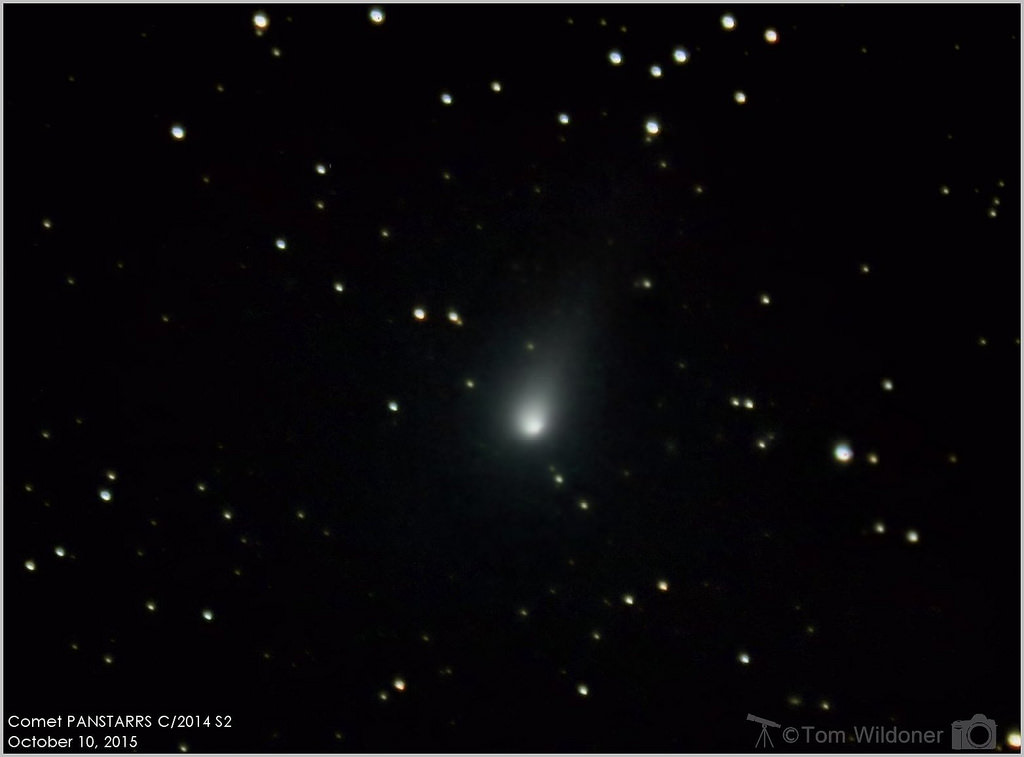Now is the time to catch binocular Comet C/2014 S2 PanSTARRS, as it tops +8 magnitude ahead of predictions this month and crosses circumpolar northern skies. Will this Christmas comet stay bright post-perihelion, rivaling other comets into early 2016?
How 'bout
Comet C/2013 US10 Catalina
, huh? The comet took center stage early this month, as it broke +7 magnitude in brightness, experienced a tail disconnection event, and grouped with Venus and the waning crescent Moon in the dawn sky.
Expect comet US10 Catalina to remain a fine binocular object kicking off 2016, reminiscent of the binocular comet
C/2014 Q2 Lovejoy
from just this past winter. But there's
another
comet for northern hemisphere residents currently performing above expectations.
Comet C/2014 S2 PanSTARRS
is the comet you most likely aren't watching, but should be. The comet has recently brightened ahead of expectations to +8
th
magnitude, and may top out in the coming weeks at +7
th
magnitude post-perihelion.
[caption id="attachment_123910" align="alignnone" width="580"]
The orbit of Comet C/2014 S2 PanSTARRS. Image credit: JPL Horizons (click all images to enlarge)[/caption]
Comet S2 PanSTARRS
reached perihelion 2.1 astronomical units (AU) from the
Sun just last week
on December 9
th
, 2015. Discovered on September 22
nd
, 2014 by the prolific PanSTARRS 1 survey based atop mount Haleakala on Maui in Hawaii,
S2 PanSTARRS
is on an estimated 2,217 year orbit, inclined at a steep angle of 65 degrees relative to the ecliptic and the general plane of the solar system. This makes for its current residency in the realm of the northern celestial pole, and the comet remains circumpolar above latitude 30 degrees north for the duration of this apparition, crossing for the constellation Draco in late 2015 into the constellation Ursa Minor in early 2016.
We get a handful of binocular comets each year, faint fuzzies looking like unresolved globular clusters. Such a passage would've went unrecorded in pre-telescopic times, and hunting for comets the likes of S2 PanSTARRS partly inspired Charles Messier to make his first and famous deep sky catalog, marking the celestial skies for comet hunters as if to say 'here be cometary impostors...'
[caption id="attachment_123911" align="alignnone" width="580"]
The projected light curve of comet S2 PanSTARRS. Note the black dots for actual observations showing the comet brightning ahead of schedule. Image credit:
Seiichi Yoshida's
Weekly Information About Bright Comets.
[/caption]
But Comet S2 PanSTARRS won't stay bright for long.
Here's the run down over the next few months of key astronomical dates with destiny for this fleeting comet. The Full and New Moon phases are also denoted, marking weeks favoring dark vs light-polluted skies.
[caption id="attachment_123909" align="alignnone" width="580"]
The path of comet S2 PanSTARRS from December 2015 through March 2016. Image credit: Starry Night Education software.[/caption]
-December 25
- th
-
The Moon reaches Full.
-December 31st: Stationary in its apparent motion, before appearing to reverse direction to the northeast.
[caption id="attachment_123914" align="alignnone" width="580"]
Comet C/2014 S2 PanSTARRS from October 14th.
- Image credit and copyright
-
Roger Hutchinson[/caption]
-January 1
- st
-
Tops out in brightness at +7
th
mag?
-January 10
- th
-
New Moon.
-January 22
- nd
-
20 degrees from Comet C/2013 US10 Catalina crossing through the constellation Draco.
-January 24
- th
-
Passes less than one degree from the +4.8 magnitude star 18 Draconis.
-January 24
- th
-
Full Moon.
-February 8
- th
-
New Moon.
-February 20
- th
-
Passes into the constellation Ursa Minor.
-February 22
- nd
-
Full Moon.
-February 27th: Closest Earth approach, at 1.83 AU distant. Moving at a maximum apparent speed of 30' (half a degree, about the angular size of a Full Moon) per day.
-February 27th: Passes just over one degree from the +3 magnitude star Pherkad (Gamma Ursae Minoris).
-February 29th: Reaches its most northerly point, at a declination 71 degrees north, just 19 degrees from the northern celestial pole.
-March 1: Drops back below +10 magnitude?
-March 9
- th
-
New Moon.
-March 18
- th
-
Crosses back into the constellation Draco.
The best time to catch Comet S2 PanSTARRS over the next few months is in the early morning hours. From latitude 30 north, the comet sits 23 degrees above the NNE horizon around 5AM local on Christmas Day; the farther north you go, the higher the comet will be above the horizon.
[caption id="attachment_123912" align="alignnone" width="580"]
Looking north from latitude 30N on Christmas Day. Image credit: Starry Night Education Software[/caption]
In binoculars or a small telescope, expect comet S2 PanSTARRS to appear as a fuzzy indistinct 'star,' which stubbornly refuses to snap into focus, like an unresolved globular. I would show off S2 PanSTARRS at a public star party under dark skies. When it comes to comets, brighter +10
th
magnitude triggers our 'is interesting, worthy of note for skilled observers' alarm.
A caveat is in order; expect any given comet to appear visually fainter than a star of the same quoted brightness. As with deep sky objects, said brightness is smeared out over the expanse of the comet, giving it an overall lower surface brightness appearance for the viewer.
[caption id="attachment_123913" align="alignnone" width="580"]
Comet S2 PanSTARRS, imaged on July 11th. Image credit and copyright:
Roberto Ferrero
[/caption]
And now for the wow factor: the last time comet S2 PanSTARRS passed Earth in the 3
rd
century BC, Carthage was battling an upstart Rome during the first Punic Wars. The comet very likely passed through the inner solar system unnoticed and unrecorded, as it was never a naked eye object. The comet's next pass through the inner solar system is out around 4232 AD, give or take a year...
Along with US10 Catalina and comet 2013 X1 PanSTARRS, expect S2 PanSTARRS to join the ranks of binocular 2016 comets... more to come on that soon.
Remember, the next 'Great Comet' could swing through the inner solar system at any time... and we're definitely due!
 Universe Today
Universe Today
